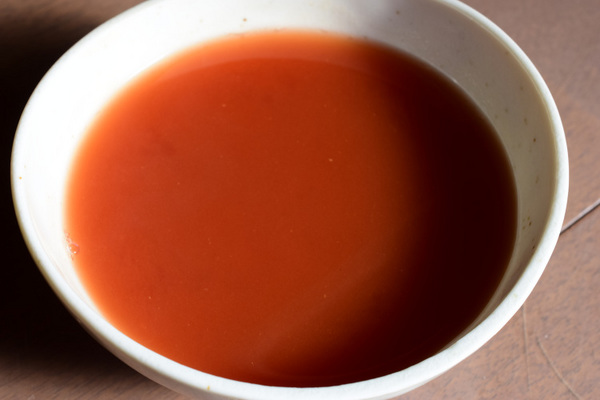Vegan Ramen Tomato Flavor ビーガンラーメントマト味 [Recipes, Winter 冬レシピ]
日本語のレシピは ビーガン、ベジタリアン情報満載の Hachidory から ご覧下さい
Happy Lunar New Year !
Do you know what year 2020 is in zodiac ?
It is the year of the rats /mice.
Last year was the year of the pig and I wrote about a happy pig and sad pigs.
Unfortunately, I have not heard about a happy mouse in my surroundings.
I always wonder why the animals are so exploited by humans though they are often portrated as our friends in the kids’ books.
Look at the infants and kids’ corner of the library and book shops. If you pick up a book at random, the probability of you find the adorable pictures of the animals is very high, perhaps nine out of ten books have the picture of the animals.
Many of the characters are animals who are personified.
Children love those animals and get affectionate to them, and so do their parents when they read those books for their kids.
The rats, the cows, the tigers, the rabbits, the dragons, the snakes, the horses, the sheep, the monkeys, the chickens, the dogs and the pigs….(I wrote in the order of zodiac)
They are different species, but all of them feel the pain and joy, have affection and mothers want to protect their kids. In that sense we are same.
Children learn this fundamental fact from the books and become affectionate to these animals.
However in some stages, children are guided to believe that animals are different from us, their position is lower than humans so it is not wrong to let them work for humans.
It is the circle of the nature.
In order to live and protect our lives, it is all right to make them feel pain and even kill them.
This is very sad, and
This is wrong.
I want to nurture children’s pure and sacred feeling towards the animals.
I want them to keep that beautiful affection and compassion till they are grown up without being succumbed to adults’ value that it is all right for humans to control other animals.
So last for a few years, I’ve been trying to make more opportunities to read Kamishibai story – Japanese traditional story telling with the big pictures- to pass this message to the kids. After reading, I listen to their feelings and thoughts, and give further talk to them.
How did you find the pictures of the mice that I showed you in the beginning?
They are the pictures of the mice who visited my home last year.
Aren’t they adorable ?
Mice visitors are nothing rare in the old houses in Japan.
And it is common to catch them in the glue traps and discard them in the dust bins.
The glue traps are very cruel making mice panic and struggle to get out of there, their skin and tails are often torn and they have to spend hours with pain and agony till they finally can die.
So never use the glue trap when you want to get rid of them !!
Tomato flavor Ramen
Ramen is so popular now not only among Japanese but also among the tourists from overseas.
It is not a traditional Japanese cuisine, but many think it is.
There are some vegan ramen shops these days but those are still rare, so if you want to eat ramen free from animal products and artificial flavors, try this recipe.
Ingredients (for 2 servings)
For bouillon
5g kombu / dried sea kelp
1pc hoshi shiitake / dried shiitake mushroom
5g kiriboshidaikon / dried radish
1L water
120ml~150ml tomato puree
I use this brand's puree
1 clove garlic
1 tsp salt
1 Tbsp white miso
1~2 tsp sesame oil
For assembling
2 ramen noodles
I used this dried noodles for this ramen.
Vegetables of your choice – I am using julliene cut Japanese leek in this recipe, for preparation, refer to https://kurinascooking.blog.ss-blog.jp/2018-01-09
Procedure
1. Soak all the dried ingredients, kombu, shiitake and kiriboshidaikon in the water 4 ~ 24 hours. If soaked enough, just remove the ingredients, if not enough, cook over medium heat and remove them just before reaching boiling point. You need about 600ml out of this bouillon for two servings.
2. Prepare the vegetables of your choice.
3. Cook the ramen noodles in the boiling water following the instruction of the package.
4. At the same time, combine the ingredients for the soup and above bouillon in the other pot, bring to a boil.
Soup only
5. Transfer the cooked ramen noodles and boiling soup into the bowl.
6. Top up with the vegetables.
Notes
l If those dried ingredients for bouillon are unavailable, replace with bouillon that you can obtain.
l The bouillon can be kept in the fridge for a week if it is winter, for a few days under hot climate.
l Those dried ingredients can be reused for other cooking. I usually marinate the kiriboshidaikon in shiokoji, put the shiitake and kombu in the separate bags and keep in the freezer. I cook them when the bag is full.
l If you found the taste is not rich enough for you, add more sesame oil.
l Adjust the amount of seasoning according to your preference.
I used the thicker remen noodles for this.
I introduced sesame and miso flavored ramen two years ago.
You can try that too if you want different flavor.
Happy cooking!
_00001.jpg)
_00001-0a138.jpg)
.jpg)
















コメント 0